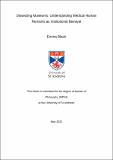Files in this item
Dissecting museums : understanding medical human remains as institutional betrayal
Item metadata
| dc.contributor.advisor | Shearer, Morven | |
| dc.contributor.advisor | Howard, Jeremy | |
| dc.contributor.author | Black, Emma | |
| dc.coverage.spatial | 106 | en_US |
| dc.date.accessioned | 2023-02-03T17:12:04Z | |
| dc.date.available | 2023-02-03T17:12:04Z | |
| dc.date.issued | 2022-11-30 | |
| dc.identifier.uri | https://hdl.handle.net/10023/26900 | |
| dc.description.abstract | Historical medical human remains were created for research through dissection, mainly without gaining consent from the deceased or the deceased’s family. Hard tissue (bone and teeth) and soft tissue (internal organs and the tissue that surrounds, supports and connects to them) were procured through acknowledged acts of punitive justice, illegal acts of grave robbing, murder and medical entitlement. This abuse is not hidden. Beyond the ‘heroic discovery – or heroic squabbling’ of developing medicine, the social history of medicine demonstrates how medical human remains are ‘rooted, unambiguously, in human cruelty and misery’. Yet, discussions on this topic in medical museums are often reframed as arguments suggesting that the harm caused was mitigated by advancement of medical research. Similarly, arguments that discount the active discrimination behind these acts by suggesting ignorance or differing moral values of the time as reasonable justification are prevalent in this area. By drawing from the field of trauma psychology and my own reflexive practice, this study aims to step away from these often circular arguments and focus directly on the human cost of medical human remains and the modern implications for museum professionals and visitors. Through the chapters of this study, I aim to provide information and knowledge gained from my own experience in working with medical human remains in the hope that it will protect both the living and dead. Ultimately, this study issues a call to courage, to remove medical human remains from display, and for the wider museum community to draw upon this study to recognise and address the impact of all forms of discriminations. | en_US |
| dc.language.iso | en | en_US |
| dc.rights | Creative Commons Attribution-NonCommercial-NoDerivatives 4.0 International | * |
| dc.rights.uri | http://creativecommons.org/licenses/by-nc-nd/4.0/ | * |
| dc.subject | Medical ethics | en_US |
| dc.subject | Medical musuems | en_US |
| dc.subject | Human remains | en_US |
| dc.subject | Institutional betrayal | en_US |
| dc.subject | Trauma psychology | en_US |
| dc.subject | Jennifer Freyd | en_US |
| dc.subject | Call for courage | en_US |
| dc.subject | Carly Parnitzke Smith | en_US |
| dc.subject | Cultural betrayal | en_US |
| dc.subject | Anatomy Act | en_US |
| dc.subject | Human Tissue Act | en_US |
| dc.subject | Equality Act | en_US |
| dc.subject | Alder Hey | en_US |
| dc.subject | Repatriation | en_US |
| dc.subject | Sexism | en_US |
| dc.subject | Racism | en_US |
| dc.subject | Classism | en_US |
| dc.subject | Colonialism | en_US |
| dc.subject | Socio-economic discrimination | en_US |
| dc.subject | Social murder | en_US |
| dc.subject | Capital punishment | en_US |
| dc.subject | David Myles | en_US |
| dc.subject | Mary Patterson | en_US |
| dc.subject | Sara Baartman | en_US |
| dc.subject | Charles Byrne | en_US |
| dc.subject | Gunther von Hagans | en_US |
| dc.subject | Robert Knox | en_US |
| dc.subject | Burke and Hare | en_US |
| dc.subject | Sui Hong Jin | en_US |
| dc.subject | Anatomization | en_US |
| dc.subject | Medical history | en_US |
| dc.subject | Murder Act | en_US |
| dc.subject | Dissection | en_US |
| dc.subject | Participatory model | en_US |
| dc.subject | Judicial violence | en_US |
| dc.subject | Act of omission | en_US |
| dc.subject | Act of commission | en_US |
| dc.subject | Activism | en_US |
| dc.subject | Education | en_US |
| dc.subject | Engagement | en_US |
| dc.subject | Community | en_US |
| dc.title | Dissecting museums : understanding medical human remains as institutional betrayal | en_US |
| dc.type | Thesis | en_US |
| dc.type.qualificationlevel | Masters | en_US |
| dc.type.qualificationname | MPhil Master of Philosophy | en_US |
| dc.publisher.institution | The University of St Andrews | en_US |
| dc.publisher.department | University of St Andrews. School of Medicine | en_US |
| dc.identifier.doi | https://doi.org/10.17630/sta/258 |
The following licence files are associated with this item:
This item appears in the following Collection(s)
Except where otherwise noted within the work, this item's licence for re-use is described as Creative Commons Attribution-NonCommercial-NoDerivatives 4.0 International
Items in the St Andrews Research Repository are protected by copyright, with all rights reserved, unless otherwise indicated.


